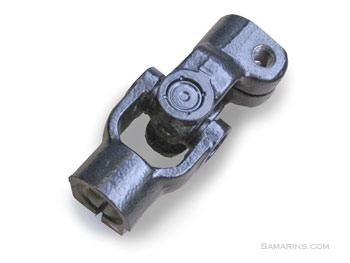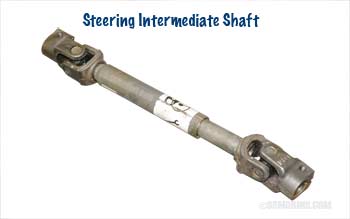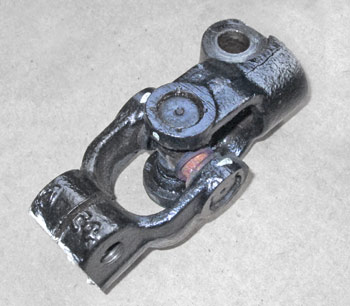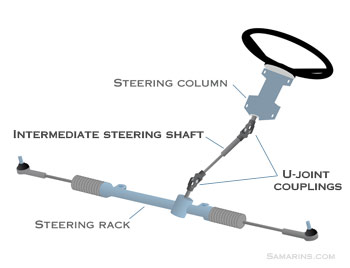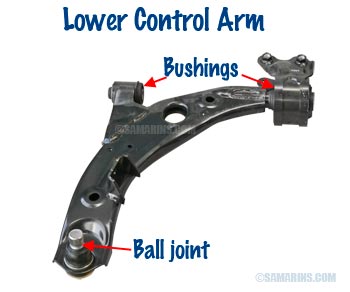Steering u-joint (intermediate shaft) problems, symptoms, replacement cost
Updated: September 17, 2021
The steering universal joint coupling, or simply steering u-joint, is a small but important part of the steering system. The steering u-joints are needed to transfer the steering force from the steering wheel to the steering rack at an angle. See how the steering u-joint works in the rack and pinion steering system below.A faulty u-joint can cause looseness or stiffness felt in the steering wheel. The steering u-joint has four needle bearings packed with grease and sealed. It's a maintenance-free part. In many cars, it can last for the lifetime of the vehicle.
Another common problem is when grease on the splines of the intermediate shaft dries out. Because the intermediate shaft has to expand and contract when rotated, lack of grease may cause light clunk or pop type noises when turning the steering wheel. If there are no other issues, lubricating the intermediate shaft splines may solve the problem. If not, the intermediate shaft must be replaced. For example, the Toyota service bulletin ST001-06 describes a similar problem in some early Camry and Highlander models. Google the bulletin number for more info.
Symptoms of a bad steering u-joint (intermediate shaft)
A failed steering u-joint can cause two types of problems:1: When the u-joint seizes up, the steering may become stiffer or jam at certain angles when rotated. There could also be a popping or clunking noise while turning.
2: If the steering u-joint is worn out or one of the bearings is corroded or damaged, it will cause looseness in the steering. When driving, it feels that the steering is loose and you always have to correct it to keep the vehicle driving straight. You may also feel that there is too much free play when turning the steering side-to-side. Watch this video of a broken steering u-joint.
A worn-out steering u-joint can also cause a rattling noise in the steering when driving on rough roads. Of course these symptoms can be caused by several different problems in the steering system and need to be properly diagnosed. A failed steering u-joint or other problems with the steering system make the vehicle UNSAFE to drive. If you are experiencing these symptoms, have your vehicle checked out as soon as possible.
Steering u-joint/intermediate shaft replacement
The failed steering u-joint must be replaced. In some cars, it comes as a separate unit, in others it comes together with the intermediate steering shaft as an assembly, see the photo. For an average car, the replacement of a separate lower steering u-joint in a repair shop will cost 0.5-1.0 hours of labor plus the cost of the part.For the replacement of an intermediate shaft you shop may charge 0.7-1.5 hours of labor plus the part.
Advertisement
How easy is it to replace the steering u-joint? In most cars, it's not very difficult, although the u-joint could be seized on the shaft and might be difficult to remove.
In some cars, it's important to mark the steering u-joint position on the steering shaft and the intermediate shaft splines, as the new u-joint must be positioned in the same way. It's best to consult the vehicle's service for the proper repair procedure. We posted a list of websites providing paid access to service manuals for different cars at the bottom of this article: Check Engine Light: What to check first, repair options.
